Media | Articles
10 Malaise Era Milestones to Silence the Haters

There’s something to be learned from any time period, even one as universally disliked as the Malaise Era (circa 1973–83). The number of innovations and popularizations that improved our lives during this era is astounding, and neglecting them in a modern car would doom that vehicle to mass-market failure. So let’s get the obligatory Ricardo Montalbán TV commercial out of the way, as Malaise Era marketing campaigns were schmaltzy, unforgettable, and almost mandatory at this point.
Now that the low-hanging fruit has been picked, let’s consume the good stuff from the Malaise Era. One could even consider these as milestones, examples of American Exceptionalism. Indeed the USA was embracing change while other countries either feared to embrace it or chose not to provide the fruits of such undertakings. That’s especially true in one particular initiative, which we must put as the first milestone in our series:
Milestone #1: Clean Air in Cities
As our population increased, the number of automobiles suddenly became a black eye for our society. And the rudimentary additions to cars of the 1960s like positive crankcase ventilation and air pumps weren’t cutting the mustard. Breathing smog in the air takes a shocking toll on your body, but don’t take my word for it: Visit a city that only recently adopted emissions controls, and your lungs/eyes/nose will make the fact clear.
Marketplace
Buy and sell classics with confidence
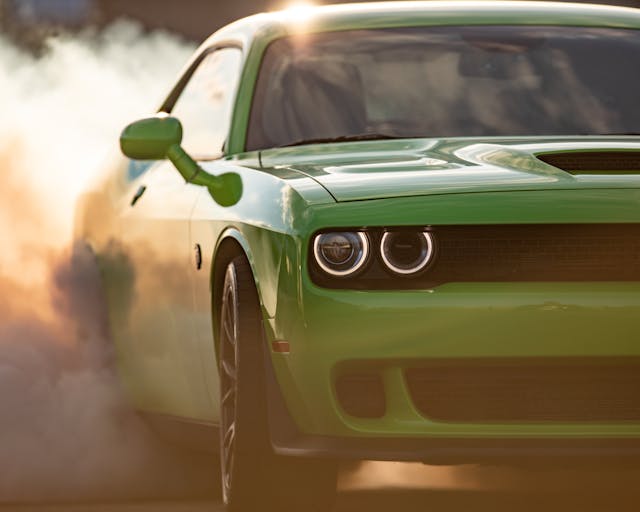
While the first two decades of catalytic converters would hold back ultimate power for those looking for serious engine upgrades, modern powerplants like Chrysler’s Hellcat prove that catalytic converters let you have your cake and eat it too.
Milestone #2: Luxury for the Masses
The personal luxury genre started in the 1960s with the likes of the Cadillac Eldorado, Continental Mark III, and even ritzy versions of pony cars (looking at you, Mustang Pony interior package). But those efforts pale in comparison to what we got in the Malaise Era. Because if you could afford a bit more than a new 1975 Pinto or Vega, well, you just got yourself a first-class ticket to Brougham-town.
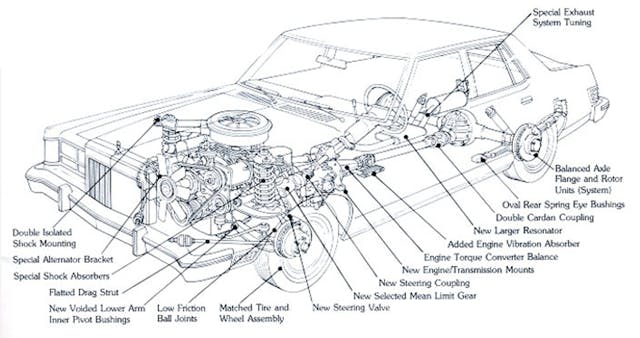
While the Brougham name became the butt of many a car enthusiast’s joke, the added luxuries were underscored with superior noise/vibration/harshness (NVH) reduction techniques: For starters, asphalt-lined sound insulation and thicker interior materials from carpets to door panels. The Lincoln Versailles above was the best and worst example of Malaise Era NVH engineering: It possessed significant upgrades from the era but a pathetic amount of parts was shared with its Ford stablemate.
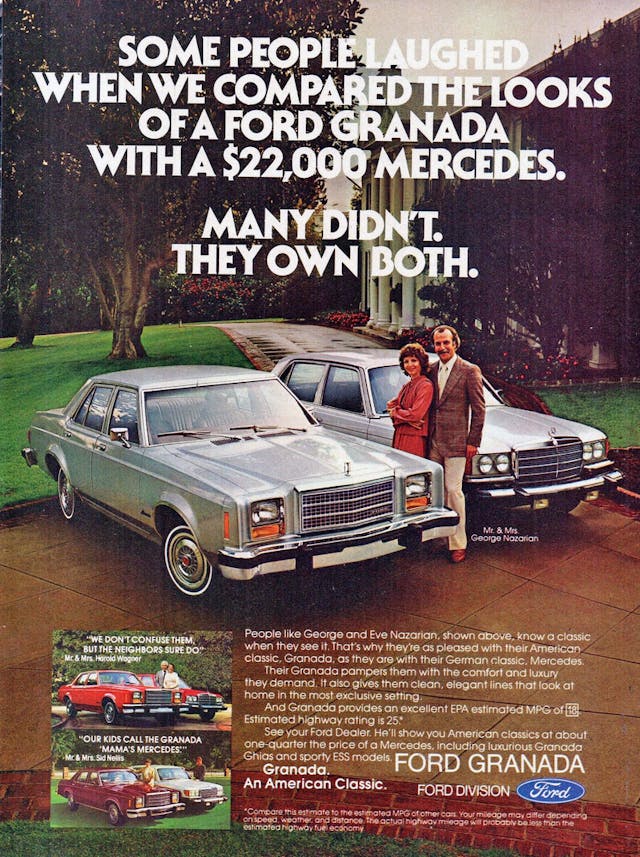
Speaking of Granada, Ford had the audacity to compare its new-for-1975 compact to a Mercedes-Benz W116. How on earth can something based on a 1960 Falcon platform, with a Falcon-derived engine and a stick axle, possibly be on the same level as a German flagship?
It clearly was not, but the Granada cost a reasonable $3800 for a base model. Even in full poverty-spec, the Granada had the telltale signs of a more premium vehicle from Germany or England, right down to the hood ornament, extensive chrome trimming, and an upscale interior with reclining seats, fake wood, and plush carpeting. We may pan Ford for its personal luxury references, but Chrysler (Dodge Aspen) and the fourth-generation Nova did the same thing.
Chevrolet bestowed significant NVH improvements upon the Nova in 1975, and the more upscale versions (LN and Concours) matched the, ahem, luxury of the Ford Granada. (The base 1975 Nova was about $800 less than a Granada.) And this Euro-centric commercial proves that General Motors was drinking the same personal luxury Kool-Aid as Ford.
Milestone #3: Lighter Land Yachts
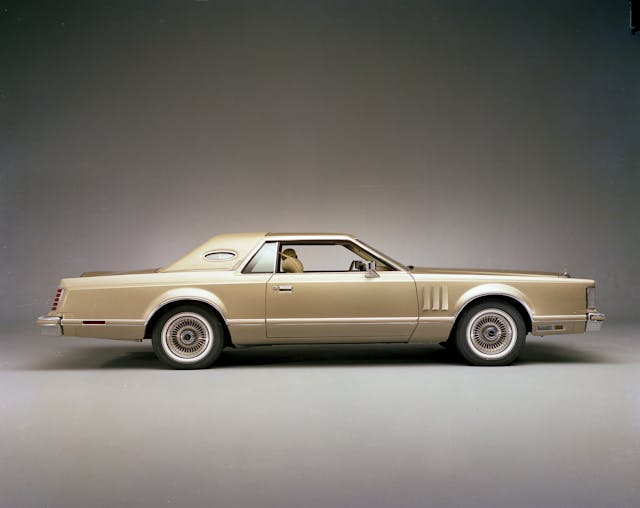
The 1977–79 Continental Mark V might be the only vehicle that’s both larger and lighter than its predecessor. While it’s a mere 2 inches longer, a 502-pound weight reduction is nothing to sneeze at.
The quarter-ton weight reduction came from heavy use of plastics in places you can see, like the revised plasti-fake wood trim, and the lightweight plastic/fiberglass front fascia holding its massive metal grille. But what amazed me was the weight reduction found in places your eyes shall miss.
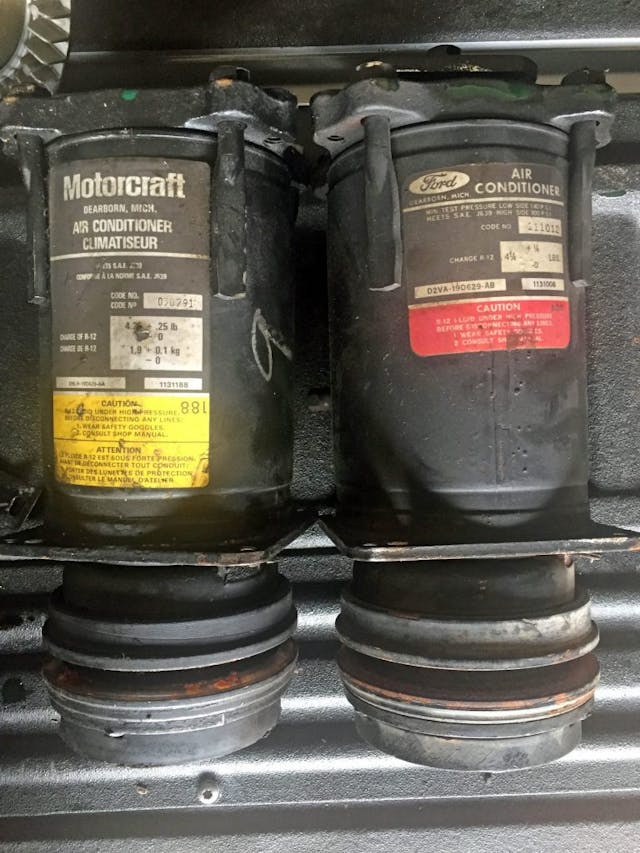
I own and restore both a Mark IV and a Mark V, and the best example of weight reduction that I’ve found are the respective A/C compressors. They may look the same externally, but the Mark V’s unit is roughly half the weight. My personal musings point to a broader trend: Malaise Era engineers were doing some heavy lifting (sorry) behind the scenes to make automobiles lighter. Or perhaps to offset the weight from those big bumpers?
Milestone #4: Bumpers That Bumped Back
For decades, Detroit designers treated the bumper as a mere styling feature, with body-hugging shapes and preposterous dagmars. The Malaise Era was a wake-up call for bumpers, getting them back to prewar duties of actually protecting the vehicle from damage. While the 1973 Pontiac Grand Am wasn’t the first car with the brand’s Endura nose, it proved the concept worked for legislation that required bumpers to become functional once more.
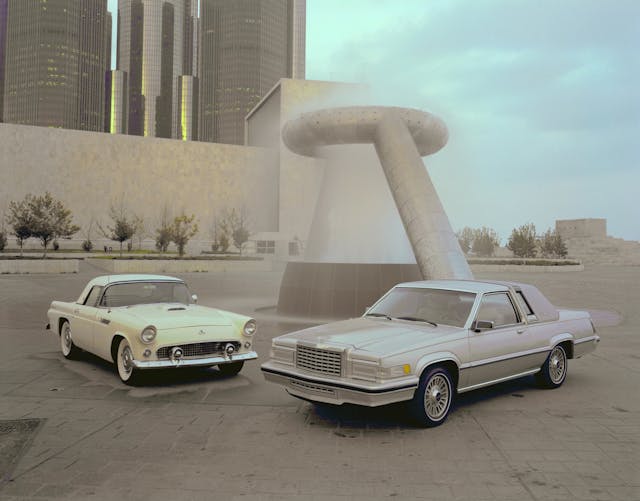
The plastic bumper had a future, as seen in the 1980 Ford Thunderbird. While this is one of the least desirable ‘birds of all time, its wrap-around bumper was trimmer than most chrome affairs and could still pass the second phase of bumper regulations that upped the damage threshold from 2.5 to 5 mph.
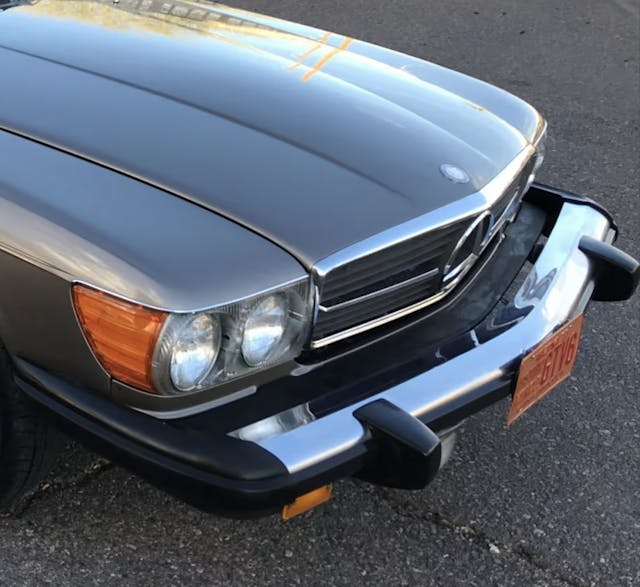
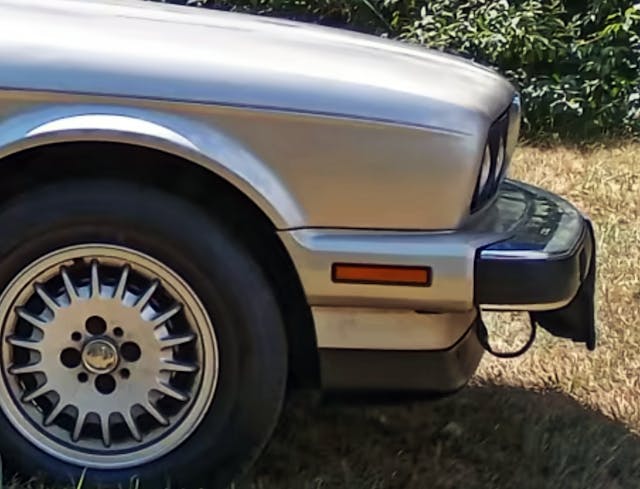
And what was the rest of the world doing? Behold the flagship Mercedes SL roadster, and Yuppie-level luxury BMW E30: Running around with battering rams years after the 1980 Thunderbird. But credit must be given to the 1982 Audi 5000, as its Thunderbird-like bumpers clearly pulled ahead of those worn by its German competitors.
Milestone #5: Adoption of Radial Tires

While the 1970 Continental Mark III (not from the Malaise Era) was the first American car with radial tires as standard equipment, Pontiac made a big deal about the benefits of radial tires in 1974 with its Radial Tuned Suspensions (RTS) for more affordable vehicles.
The radial tire’s softer ride (more sidewall flex), longer tread life, and lower rolling resistance made it the right move over the now antiquated bias-ply rubber. Tire manufacturers (save for the Firestone 500 debacle) wisely made the transition, as the writing was on the wall for all passenger cars. And speaking of lower rolling resistance …
Milestone #6: Better Fuel Economy
While much of this effort inadvertently reduced oil pricing shocks from OPEC during the Malaise Era, making lighter, sleeker, and more efficient cars really helped lower fuel bills for American motorists. One of the major improvements of this era was the large-scale implementation of the automatic overdrive transmission.
Ford released its Automatic Overdrive (AOD) transmission in 1980, while GM introduced the 200- and 700-R4 in 1981 and 1982 respectively. Chrysler’s A500 overdrive didn’t hit the streets until 1988, far after the demise of the Malaise Era. Chrysler’s belated efforts were still two years before Mercedes-Benz released the 722.5 overdrive gearbox (1990). While a stunning delay in overdrive implementation, Mercedes did cheat the system via tall axle ratios paired with shorter gears in a non-overdrive gearbox. (My experiences with them were disappointing, especially at less than full throttle.)
Milestone #7: Life-Saving Technology
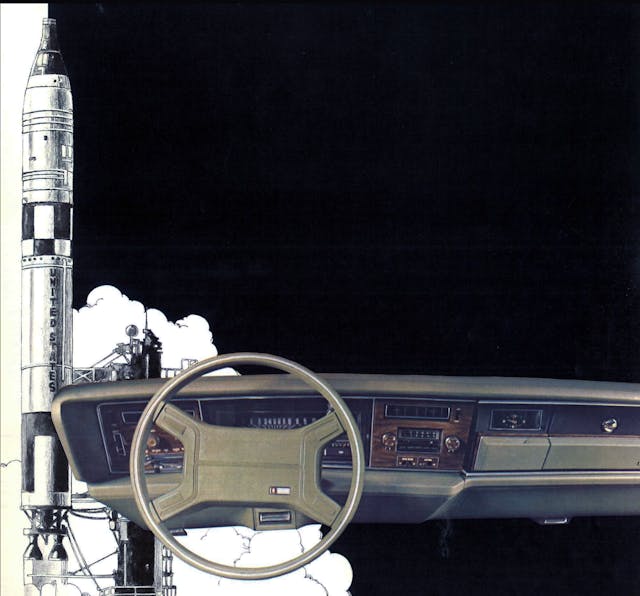
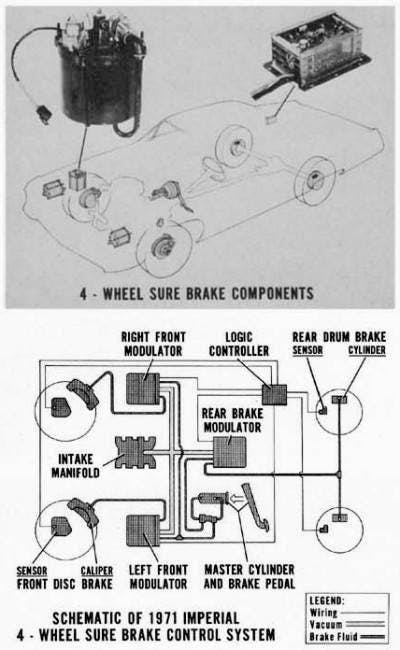
The days of lap belts, padded dash tops, and fully drum-braked vehicles were either gone or disappearing by the start of the Malaise Era. In their place we had three-point seat belts, fully impact-absorbing interiors, and front disc brakes (1975) across the board. It was good for both the future and the past, as countless first-generation Mustangs grabbed the front spindles and disc brakes from the aforementioned 1975 Ford Granada.
But there was much more to this era of automotive safety, as GM introduced the Air Cushion Restraint System (ACRS) in the 1974 Oldsmobile Toronado. (Mercedes was working on a similar system, which it released in 1980.) GM’s ACRS offered the modern airbag experience for driver, passenger, and center passenger occupants, while Chrysler sold the first four-wheel, computerized anti-lock braking system on an American car in 1971. (Yes, that’s technically before the Malaise Era.)
While these advanced safety systems were poorly received and suffered from short production lifespans, the post-Malaise technology boom made them palatable for everyone. Who knows how many lives ABS and airbags have saved in the last 30 years, but we have the Malaise Era to thank for all of them.
Milestone #8: Aerodynamics for All
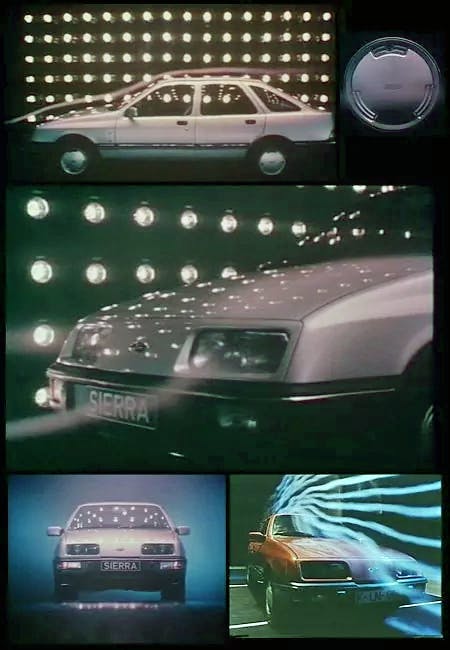

Wind tunnels have shaped cars since the Chrysler Airflow, but things didn’t get serious until Malaise Era demands put fuel economy on everyone’s mind. And one great way to lower fuel economy is to reduce the amount of fuel needed to push a car through the air.
Technology made plastics both lighter and cheaper in this era, quickly turning bumpers into tools for air manipulation. And it was indeed for all, as shown in cheaper cars like the German Ford Sierra (above) and traditional sports cars like the refreshed 1980 Corvette. That C3 Corvette infused front and rear aerodynamic elements from the 1978 Corvette Pace Car, lowering its drag coefficient from an awful 0.503 to a significantly less awful 0.443. (The C4 Corvette was a sleek 0.34, and that engineering technically happened at the tail end of the Malaise Era.)
Finding highway mileage ratings for the 1980 Corvette from the EPA was impossible, but the 1980 car did get an extra mile per gallon in the city over the 1975 model, rated at 13 mpg. Factor in the extra drag at highway speeds and it’s fair to extrapolate an even more significant improvement to the highway fuel economy of the 1980 Corvette; for 1975, that figure was only 20 mpg.
Milestone #9: Computers Outside Academia
Computers were still a flight of fancy in the Malaise Era, though some of us had an Atari 2600 or a Bally Home Library Computer by 1978. While I suspect the would-be Bill Gates of the world weren’t the target market for Cadillac’s Seville import fighter, the hardware that made home computing systems likely interchanged with Cadillac’s Trip Computer. This system showed everything from engine rpm to the Seville’s Estimated Time of Arrival (ETA) to a pre-programmed destination. It’s a great system that actually worked, and today everyone benefits from ETA calculations in our smartphone-based navigation systems.

That Seville also had a Bendix electronic fuel-injection system, but the other two Detroit manufacturers were taking a stab at in-house, in-car computer designs. The Malaise Era system that earned enough goodwill to stand the test of time is likely Ford’s EEC System, now in its seventh generation. The original EEC-I computer lacked the wattage to run more than a handful of sensors (often needing vacuum actuators for operation) but the die was cast, and engine computers were here to stay. Speaking of computers …
Milestone #10: Computer-Aided Design For All
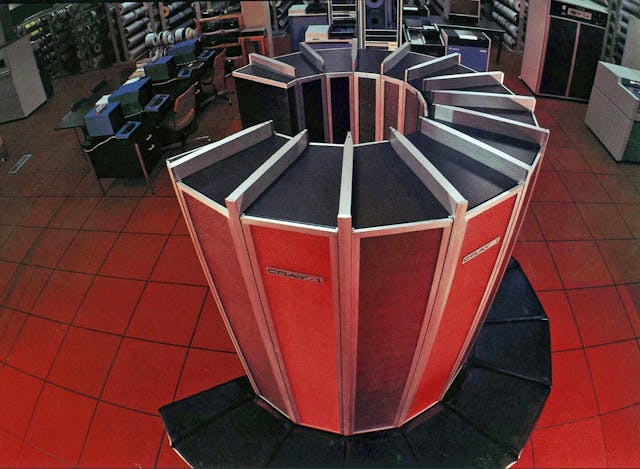
Supercomputers were all the rage in the 1970s, provided you had the millions of dollars needed to buy one. And they allowed for computer-aided design, a topic I previously wrote about that inspired this list of Malaise Era milestones.
Computer modeling opened doors to advanced design concepts like ergonomics, finite element analysis, and aerodynamic and crash-test modeling for all cars. The sheer number of doors opened by computers is impossible to count in our modern society, and I reckon most of those doors were worth opening. The portals pertaining to modern automobile innovations are “must sees,” and we can clearly thank the Malaise Era for bringing computer technology to our beloved automobiles.
So how do you feel about the Malaise Era now?
***
Check out the Hagerty Media homepage so you don’t miss a single story, or better yet, bookmark it. To get our best stories delivered right to your inbox, subscribe to our newsletters.
























Sorry the very few positive things here are still not enough to redeem the 70’s. While the cities got cleaner most were due to the loss off jobs and industry.
Sorry the Concours and the Granada were not luxury.
Lighter land Yachts. were mostly the later down sized Eldorado and Riviera as well the full size GM cars of this era. They right sized them. The rest were still struggling on what to do.
Few got the bumpers right as they were stylistically a mess for many cars. Pontiac had already has the endura bumpers in the 60’s and everyone adopted them in time. Same with Radials. They were coming in the 60’s. Delorean lobbied hard for them in the 60’s for the GTO.
Fuel MPG improvements were not great if much. That was more post 1980 where FWD and smaller cars arrived.
Improved safety was started in the 60’s and just has progressed since then.
Aero came and improved the cars efficiency but did it really improve the looks?
Computers came but were more of a burden then a benefit in the early years. They were limited and not always reliable.
Computer aided design started but it took a while for it to really benefit much.
The 70’s were not an era to celebrate but one to learn from. Automakers tried to make things cheap to fix emissions fast due to government regs being forced on them. It led to more expenses and small gains on cars that just were not as powerful or efficient. This drove them to smaller engines and FWD in the early 80’s that really left us with cars that were left wanting for the most part. Celebrities’. K cars and Tempos were not things we really would want to repeat.
We did gain some ground but still many mistakes were made. Things started to improve in the 90’s and finally hit their stride post 2000.
Today they are trying to force the EV models on us like the converters and bumpers of the 70’s. Just this time the cost are X6 what we were faced with back then. Again you can pass regulations but you can’t force it on a pubic that does not want them.
The auto industry is in trouble and America is down to two MFGs. GM is holding it’s own but if Ford was not owned 51% but the Ford family they would have been bought up and stripped of their trucks and the rest of the line up scrapped. Today is a good day they are $13.17 at the moment but while that is good for them that is not good for any car company.
We can put on the rose colored glasses but that changes nothing.
I am not trying to be negative here but I lived though this and it was not all that nostalgic. I ended up working on these cars from the 70’s as they aged and I can tell you they were the dark ages. Sure we had a Vega with Fuel Injection with a Cosworth head. But it was not a good car. Same for many others like the Aspen Road Runners and even worse the Mustang II.
The best thing about the Córdoba was Ricardo’s commercials. If the car was as good as he sounded they would have had a winner. Ford just never appeared to know what to do with the T bird. It was a 2 seat car. Then sport luxury. Then just a restyled Lincoln. Finally a Torino. Imagine if they had stuck to one model and refined it.
To be fair GM also had a thing about big door coupes. The Monte to the Camaro . They all had sagging doors in just a few years. We used to bend them back into shape with a floor jack so customers could shut the doors. yes it was crude but the cars were not worth fixing correctly.
EVs have the added overhead not only of having to buy the vehicles, but is going to cost hundreds of billions to build out the infrastructure to charge them, so it’s an order of magnitude worse than the 70s car regs.
And I recently used a floor jack to realign the hinges on a 1973 Grand Am. Worked like a charm. 🙂
There’s a great similarity between the ‘70s and now. Government forcing technology not ready for prime time. As another poster noted, it’s much worse this time. The ‘70s forced changes to ICE cars, now we have activists forcing a whole industrial policy.
v6: amen! Radial tires and the return of overdrive, thumbs up. The rest — iffy! The automakers were not primarily to blame for the state of the art during ther malaise — and yet they were, collectively. GM and the rest were in big-time denial, and ignored/resisted any changes decades before the safety and smog issues finally called in their invoice! Enjoying 400-bhp muscle coupes had it’s backlash, after all.
I often get the impression that some folk are just trying to plump up the image of the cars their generation got stuck with — and bolster they desirability and VALUE in the collectible market!
Emissions and fuel economy are certainly to be hoped for, aerodynamics that really work are laudable, but at what cost, in the end? I do not want to bring back the ’55 Chevy — modern enhancements make those cars so much better — but what we got was a lot of disposable transportation-appliances, nothing more in most cases. And, our old crocks if made to meet emissions… never mind!
No, not for me. You like ’em, you keep ’em! Wick
The Professor has spoken….
By the 70’s Denver very much had a ‘brown cloud’ because of cars. There were days in the winter when we couldn’t see the mountains from our house because of it. The pollution index was a daily part of the weather report. By the late 80’s it was only rarely a problem. I don’t miss the bad old days of the 70’s growing up in Denver at all.
Was some of the improvement due to lower use of fireplaces and the ban on studded tires?
Working at a ford dealer in the 70s I can attest that the Granada was not the same ride, or feel of a Mercedes, but it had that “look”. I’d drive one today with the stick shift on the floor in emerald green with a white vinyl top if I could find one. Unmentioned was the ford Elite (Torino) that really rode very well and looked like luxury as well. Let’s bring back colorful cars and interiors.
Hi Bill.
I had a 1976 Granada with three on the floor manual with an inline 6; The gear ratios were the worst. Low was too low and 2nd was too high. I had to wind itin low and then had a slow swcond when trying to merge. The air conditioning system fuse melted in the fuse panel and the fan switch melted too in this Houston climate. I sawed of a spike in [lace of a fuse and added a fuse down stream. The main bearing of the engine knocked to solve that I bought two sets of main bearing standard and 2 under. I installed the top half as standard and 2 under for the bottom half to get the right clearance. It lasted for 122,000 miles and sold it.
Take care and God Bless,
P.S. Next car an ’82 Accord.
Cannot agree on the majority of air quality improvements being due to job and manufacturing losses. Some, sure, but I do not think that studies would back up it being the majority.
First, the move to EVs is a world thing, not an American thing. Actually it’s a move away from burning fossil fuels.
Second, this may not be popular, but I say the Mustang ll actually kept Ford alive. They sold millions.
Third, I owned two Cordobas. I thought they were great American Iron. Perform well? No, nothing did in 1978. Comfortable and quiet? You bet.
If the cars from this time period was so bad, why are there so many being collected? Today with the move away from ICE is just like the malaise Era. It’s a learning curve.
Lastly, nobody is mandating EVs. There are other options being worked on. Hydrogen for one
“Second, this may not be popular, but I say the Mustang ll actually kept Ford alive. They sold millions.”
Agree
Hey, I “had a 78 Lincoln
Very high performance & great ride.
Glad you touched on CAD. The first car to really successfully utilize it was the Nissan Z32.
It looks like Ford needs to thank GM for those lighter air conditioning compressors……
Zing!
Then GM went to the two piece split aluminum die cast compressor body next. Very light but…Junk! And this is from a guy who was in the die cast business in the 80’s. GM/Harrison Div shopped that tooling every year. Prone to failure due to the split vertical bore where the two pieces came together and GM made the vendor eat it. In general the refrigeration compressor industry has moved offshore and produces…junk.
It became all Japanese companies mfg in China.
The last good compressors were the six piston Garrison. Though my 85 Pontiac is still on the R12 it came with. That is even in a Fieto with the lines running the length of the car.
I’ve read both Sajeev’s “pros” and hyperv6’s “cons” (both loosely speaking) and tried to fairly consider both. The problems I have, I think, are:
1) the term “Malaise” just gives me a downer feeling from the get-go, and I have trouble getting past it
2) I had significant driving time well before that era began, and thus had real first-hand experience of the drop-off of nearly everything fun behind the wheel when it hit – major disappointments hit hard and last long
3) quite a few of the “pros” don’t really resonate with me as being improvements – “Luxury for the masses”, for instance (I was never into luxury to begin with, and the faux luxe of Granadas and Cordobas never fooled me. And computers in cars are the Devil, IMO.
I prefer “brougham era”. The list in the article and comments counter-pointing it sum it up pretty well.
Style over performance (market had matured from musclecar*, the pollution regs are overused as an excuse rather than just a factor. Sales success of various new models like Mustang II and Monte Carlo shows this). That 70s colour palette, the brougham styling cues that found there way onto everything… even Camaros. Some great engineering and design gets overlooked (5mph bumpers are generally hideous, despite working, for example) but if you approach the broughamage as makeup and strip it back –you can make things like a 74 Cutlass look quite sporty, especially in a less dated colour scheme and an engine that puts some real power to the road combined with Day 2 musclecar style wheels.
Put the 69-71 engine options into a gen 2 Camaro it will be superior in every measure (like the car mags do). IF one prefers the look of a 68 well that’s a different argument.
*I personally prefer the typical musclecar era styling cues (coke bottle fuselage, etc.) but at the right price there are 70s vehicles I would happily own.
I also prefer early 60s GM bubble top roofs to most other designs, but colonnade is structurally superior and can look good too (you also got rear passenger head room unlike a lot of things today). The influence of safety regs in this decade is a big deal… things like 4-door hardtop sedans went away for good reasons –that stub pillar starts to rot the doors are a mess, even if it isn’t rotten and you get t-boned you are a mess. 70s seatbelts are a lot better than my 69 Mustang’s that’s for sure. But improved safety was a Tucker selling feature decades prior, and things like collapsing steering column was 60s (and lap belts being common) so it isn’t like 70s owned safety, but it did modernize.
Best to term it a time of transition.
The greatest issues were mfgs were tasked with many changes and they tried to do them all in a short span. This means budgets were stretched and it took years to get every thing where they needed it. Also time for technology to catch up.
The 70’s were a time of many government regulations that were forced too quickly. Much like the EV regulations today.
Absolutely agree. As someone who was actively in the auto industry in the ’70s, the evolution was shaky, but substantial. Not all of the changes were for the better; but they led the way to the amazing performance, safety, and fuel economy of today’s ICE cars.
Please note once we caught up with tech and to better systems like FI and computers that could handle it we are at the golden age today. We are entering a new age of transition but this time the costs are greater and need for more tech.
All of the plusses of the malaise era tend to align with current minuses with modern cars… emissions taking precedence over performance and economy… safety taking precedence over styling… and electronics taking precedence over owner-serviceable parts. All of it adding up to a better car as a consumer product, but with increasingly less soul. Other than the at the high-end, I haven’t seen a car in years that was just something I had to have.
It is what happens when you force something vs letting it happen when it is ready.
LOL—How dare they try to force us not to drive Drunk—as humans change Scare us— The 70s were the Beginings of very positive change—
” Speaking of Granada,” you forgot about the Lincoln Versailles. Those 9 inch rears had disc brakes were sought after junkyard items before the days of just order a kit. _ Sorry Hyper but the Ford family does NOT own 51% of Ford. They actually only own about 5%. But not all stocks are the same.They still maintain roughly 40% of the voting power (which is apparently enough) because their shares are Class B. A more common practice than one might think in the corporate world. _ The aero T-bird has its shape because the designers insisted they could improve mpg and make CAFE with a slippery windcheater. Those NASCAR guys loved them too as an additional reward. For my money a much better looking car than the 80 model shown here as well._ Not every misstep taken by the manufacturers can be blamed on federal regulations. They were all pretty much caught with their pants down when the oil embargo came and there were lines at the pumps.Ten dollar maximum purchases. allowed. So they needed to react quickly to changing buyer demands at a time when sales were slumping and there were consequently fewer dollars available for R&D. Caught between a rock and a hard place. As good as in house testing is there still is nothing like real world data. -” Try fail, try harder, fail better.” Sometimes when things absolutely need to evolve, they require a push.
Point is The company is listed on the New York Stock Exchange and is controlled by the Ford family; they have minority ownership but the majority of the voting power.
Their stake prevents a sell out when the stock is dangerously low as it has been for a while. Also the debt they have is still a factor.
We cannot afford to lose another MFG of this size.
(ps) Sorry Sajeev, accidentally scrolled past the Versalles tech.
I beg to differ- my family had several of the Celebrity/Ciera type cars, and other than the leaky steering rack in the ’83, they were great cars. Good economy, roomy, good stereo, I liked the looks post 86 Euro make over. My favorite was my ’87 Ciera 2 door Coupe with the fastback glass and, the 3.8 v6 and the FE3 suspension. That car ran like stink. Effortless cruising at 90+, it would kick itself out of OD at 118. With my current commute, I wish I had it back.
Results may vary.
We ran through several 305 powered B-bodies and they were all great.
The handful of 2.8 and 3.1 powered GM front drive cars were pure trash. The 3.8 Century was decent, but not stellar.
Everything changed with the first LeSabre.
It’s amazing that a Fuel Injected 3.8 made as much power as the 305. Carb or aTBI.
The cars of the 70’s-80’s were ‘OK’. I’d rather have one of those than one of the overpriced computerized nightmares on wheels sold today. I think the big problem was that manufacturers went to longer periods between styling changes to save development costs. Body styled could look the same with only small changes for ten years (still that way today). It’s not like the 50’s-60’s when cars looked fresh each year and got a major redesign every three years. The ‘malaise’ also came about because the tech couldn’t keep up with the regulations making cars under powered slugs. Quality has always been an issue but came to a head when people quit accepting whatever the Big Three threw out there because there were more choices with imports. There were a few stylish cars during the period.
I owned a 1977 Olds 98, first year of the downsized GM C-body cars. There was a world of difference between that and the previous generation. It was one of the few cars done right in that era. The 403 engine kinda-sorta did the job, but I put over 300,000 miles on it with no rebuild. And it handled much better than you might expect on the full size chassis. It’s the car I miss most out of everything I’ve driven.
If Ricardo Montalban’s ’75 Cordoba was a few pounds lighter and came with a specially-built 2 barrel Slant Six instead of the V8s it was saddled with I’d want one! That US makers FINALLY put disc brakes in their standard offerings (in the front, at least) was an achievement of sorts of the malaise era.
I seem to recall that Car & Driver tested a 6-cylinder first-gen Cordoba, and it was quite a stone. I certainly would not want one, even with a 2V carb swap.
I believe this article would have been better suited for last week – on April Fools day.
You need to take a closer look at why the EV uproar is occurring. Fossil fuel has a limited future, there is only so much of it left. Unless someone finds a way to formulate synthetic fuel. Our curr automobiles are going the way of the dinosaurs (and their habitat), that we currently operate them on. Just saying, something must be done….
That’s funny! In my 1973 high school conservation class they taught us that the world had only a 25 year supply of crude oil left. By the year 2000 scientists told us we had only 25 years left before the world was out of fuel. By 2017 they were saying we only have a 200 year supply of crude oil. Now they admit they don’t fully understand the process in which crude oil is formed. Whenever they say you have to trust the science, DON’T.
It’s called drill baby drill